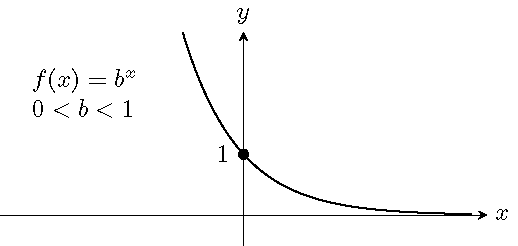Topic 16 Exponential Functions
16.1 Half-life
Half-life is the time required for a quantity to reduce to half of its initial value.
A certain pesticide is used against insects. The half-life of the pesticide is about 12 days. After a month how much would left if the initial amount of the pesticide is 10 g? Can you write a function for the remaining quantity of the pesticide after \(t\) days?
More examples on exponential functions can be found on http://passyworldofmathematics.com/exponents-in-the-real-world/.
16.2 Definition and Graphs of Exponential Functions
Let \(b\) be a positive number other than \(1\) (i.e. \(b>0\) and \(b\neq 1\)). The exponential function \(f\) of \(x\) with the base \(b\) is defined as \[ f(x)=b^x\quad\quad\text{or}\quad\quad y=b^x. \]
Graphs of exponential functions:


The exponential function \(f(x)=b^x\) is a one-to-one function: any vertical line or any horizontal line crosses the graph at most once. Equivalently, the equation \(b^x=c\) has at most one solution for any real number \(c\).
16.3 The Natural Number \(e\)
The natural number \(e\) is the number to which the quantity \(\left(1+\dfrac1n\right)^n\) approaches as \(n\) takes on increasingly large values. Approximately, \(e\approx2.718281827\).
16.4 Compound Interests
After \(t\) years, the balance \(A\) in an account with a principal \(P\) and annual interest rate \(r\) is given by the following formulas:
- For \(n\) compounding periods per year: \(A=P\left(1+\dfrac{r}{n}\right)^{nt}\).
- For compounding continuously: \(A=Pe^{rt}\).
Example 16.1 A sum of \(\$10,000\) is invested at an annual rate of \(8\%\), Find the balance, to the nearest hundredth dollar, in the account after \(5\) years if the interest is compounded
- monthly,
- quarterly,
- semiannually,
- continuous.
Solution.
- Find values of \(P\), \(r\), \(t\) and \(n\). In this case, \(P=10,000\), \(r=8\%=0.08\), \(t=5\) and \(n\) depends compounding.
- Plug the values in the formula and calculate.
- ``Monthly’’ means \(n=12\). Then \[ A=10000\left(1+\frac{0.08}{12}\right)^{5\cdot 12}\approx 14898.46. \]
- ``Quarterly’’ means \(n=4\). Then \[ A=10000\left(1+\frac{0.08}{4}\right)^{5\cdot 4}\approx 14859.47. \]
- ``semiannually’’ means \(n=2\). Then \[ A=10000\left(1+\frac{0.08}{2}\right)^{5\cdot 2}\approx 14802.44. \]
- For continuously compounded interest, we have \[ A=10000e^{0.08\cdot 5}\approx 14918.25. \]
In the compounded investment module, the \(\frac rn\) is an approximation of the period interest rate. Indeed, if the period rate \(p\) satisfies the equation \((1+p)^n=1+r\), or equivalently \(p=\sqrt[n]{1+r} - 1\). Using the formula \((1+x)^n=1+nx+\frac{n(n-1)}{2}x^2+\cdots +x^n\), one may approximately replace \(1+r\) by \((1+\frac rn)\) and obtain the approximation \(p\approx \frac rn\).
Example 16.2 The population of a country was about 0.78 billion in the year 2015, with an annual growth rate of about 0.4%. The predicted population is \(P(t)=0.78(1.004)^t\) billions after \(t\) years since 2015. To the nearest thousandth of a billion, what will the predicted population of the country be in 2030?
Solution.
The population is approximately \[ P(15)=0.78(1.004)^{15}\approx 0.828 \quad \text{billions}. \]
16.5 Practice
Problem 16.1 The value of a car is depreciating according to the formula: \(V=25000(3.2)^{-0.05x}\), where \(x\) is the age of the car in years. Find the value of the car, to the nearest dollar, when it is five years old.
Problem 16.2 A sum of $20,000 is invested at an annual rate of 5.5%, Find the balance, to the nearest dollar, in the account after 5 years subject to
- monthly compounding,
- continuously compounding.
Problem 16.3 Sketch the graph of the function and find its range.
- \(f(x)=3^x\)
- \(f(x)=\left(\frac13\right)^x\)
Problem 16.4 Use the given function to compare the values of \(f(-1.05)\), \(f(0)\) and \(f(2.4)\) and determine which value is the largest and which value is the smallest. Explain your answer.
- \(f(x)=\left(\frac{5}{2}\right)^x\)
- \(f(x)=\left(\frac23\right)^x\)